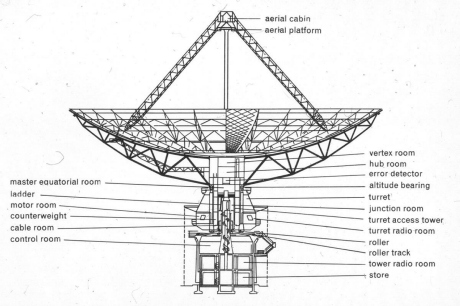
Construction of Canada's Largest Radio Telescope
The construction of the 46m antenna was a complex task in involving many organizations. The extraordinary size of the parabolic surface made the construction task especially memorable.
As with any large mechanism, the antenna was constructed in phases. First a concrete pedestal building was constructed. The four floor building weighs approximately 400 tones and has a footing that reaches the bedrock. On the roof of this turret is mounted a circular track that supports the moving mass of the telescope.
Next the a central spiral staircase, and hub complex is constructed to enable engineers to install the antennas superstructure. Giant ribs that will support the steel parabolic surface are installed and bolted in place using a giant boom and crane. Further support structure is installed by riggers to link together the primary supporting beams. Once the support structure is completed, the steel surface is bolted in place and adjusted to meet the antennas demanding tolerance. The four support beams and the aerial cabin are raised and installed.

The instrument is then painted with matt white paint using boom lifts equipped with spray systems.

The telescope is rotated to enable final painting of hidden surfaces.

Painting is finished! Completed, The moving part of the instrument weighs approximately 1000 tones.
Now the infrastructure is completed, engineers hurry to finish the electronic control system that will point the antenna to high precision at distant galactic sources. A complex feedback system uses a mechanical servo to convert coordinates and control the system. An error detector unit trims the instruments position to the intended target. Central to the telescope control is a master equatorial unit invented by Barnes Wallis, who also invented the dam-busting bouncing bomb using in World War II. The device allows celestial tracking of the telescope by the single axis rotation of a small dummy equatorial telescope. The design avoids the need for a full equatorial mount that are prone to mechanical problems.

The Algonquin Radio Observatory antenna leads the world in high precision pointing.